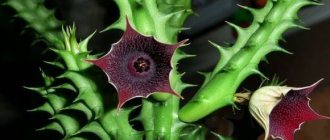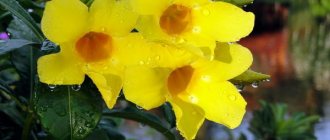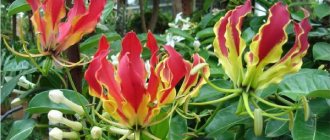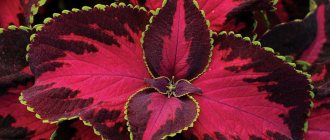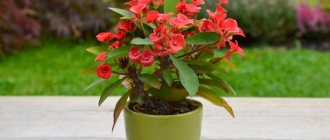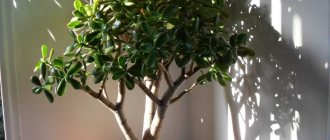The monocotyledonous plant Haemanthus is a member of the Amaryllidaceae family. Under natural conditions, it can be found in South America. This genus includes more than 40 different species. The name “gemanthus” was given to the genus by Pitton de Tournefort, this is due to the fact that the type species has flowers of a deep red color; from Greek the word “gemanthus” is translated as “bloody flower”. The plant was described by Carl Linnaeus in 1753, but he left the name the same. The most popular among flower growers is the white-flowered haemanthus (Haemanthus albiflos); it is also popularly called “deer tongue” or “elephant ear”.
Useful properties of hemanthus
Hemanthus purifies the air, saturating it with oxygen and ozone. The plant also helps improve “electrostatics”. When placed near electronics, it significantly reduces its negative impact. Hemanthus normalizes metabolism in the body, reduces blood pressure and accelerates recovery processes. The attractive appearance of the plant helps create a pleasant and comfortable environment in any type of room.
Origin, description of appearance, distribution area
This flowering perennial was first described almost two centuries ago by the Swedish botanist Carl Linnaeus. And at the end of the last century, about 20 varieties of Hemanthus were allocated to a separate family of Amaranthaceae.
By the way! Translated from Greek, "Hemanthus" means "bloody flower" .
Description of Hemanthus:
- Hemanthus belongs to the bulbous plants of the monocot genus.
- Until Hemanthus begins to bloom, it is very similar in appearance to amaryllis. In both plants, the bulbs produce 2-3 pairs of leaves located oppositely. Their foliage is elongated, widened at the oval ends. It usually hangs on opposite sides of the flowerpot.
- Deer's tongue has no more than 6 leaves, and new foliage grows when the old one dies. Only a couple of leaves are renewed each year. The bulb of this plant, shaped like an egg or a pear, is usually planted completely in the ground.
- The flowers are collected in umbrella-shaped inflorescences - small red flowers, from each stamens grow, larger in size than the flowers. Less often, white flowers appear on the elephant ear.
- Each inflorescence is framed by bracts of the same color as the flowers; there can be from four to 7-8 pieces.
- The aroma of blooming Hemanthus is not very pleasant.
- Every plant has the ability to self-pollinate, and this is a valuable quality for a houseplant.
- After flowering ends, fruits are formed on the peduncles - berries of white, pink, orange or red color, with a radius of up to 0.5-1.0 cm, with a characteristic odor. The first buds appear in the first ten days of July, and flowering continues until the end of summer.
- And in the second ten days of September, fruits begin to set on the peduncles. They fully ripen only towards the end of November - beginning of December, when the fruit boxes acquire a characteristic orange color with a red tint. Ripe seeds are usually collected and used to further grow new flowers.
Under natural conditions, deer tongue grows in tropical regions of the African continent. You can meet it on the slopes of mountains, as well as in tropical forests.
Caring for Hemanthus at home is not difficult, and even a novice gardener can handle this task. And if you purchase different varieties of elephant ear, then a mini-greenhouse of beautiful decorative flowering indoor plants will appear on the windowsill.
Hemanthus: care at home. Briefly
Hemanthus at home requires compliance with certain agricultural techniques:
| Temperature | Moderate, in summer 23-25°. In winter not lower than +18°. |
| Air humidity | Average. During the flowering period, it requires spraying. |
| Lighting | A well-lit place with slight shading in the summer. |
| Watering | Moderate 1-2 times a week. Limited in winter. |
| Soil for hemanthus | Highly nutritious, fluffy. A drainage layer is required. |
| Feeding and fertilizer | During periods of intensive growth, once a month. |
| Transfer | Once every 3-4 years is enough. |
| Reproduction | Children and seeds. |
| Features of cultivation | If seed collection is not planned, the peduncle is cut off. |
Common problems
Hemanthus diseases are not a particularly common problem, since most often this occurs due to violations of care standards.
However, it is also necessary to understand the issues of diseases and pests of this plant.
The most common symptoms that indicate the presence of any problems are:
- Lack of flowering.
The most common cause of this symptom is the size of the pot.
To get rid of it, you just need to transplant the plant into a new container and water it for the first time with a composition containing a biostimulant.
- Yellowing of blood lily leaves indicates that the plant has a lot of water - just change the watering regime or transplant the plant to a new drainage.
Also, yellowing of the lower pair of leaves in the fall indicates solely the preparation of the flower for winter.
- The appearance of spots on the leaves and slower growth indicate the possible presence of pests.
The plant urgently needs to be carefully examined and the issue of their destruction resolved.
The most common pests in the case of hemanthus are:
| aphid; | scale insect; |
| thrips; | spider mite. |
If the presence of such pests is detected, it is necessary to treat the plant with a soap solution and use insecticides.
Hemanthus: care at home. Details
Caring for hemanthus at home must be carried out in compliance with certain conditions:
Hemanthus flowering
Hemanthus blooms in spring after a dormant period. An important condition for flowering is keeping it cool in winter.
A thick peduncle with a spherical inflorescence appears near the false stem. After pollination, it produces fleshy red berries. The first flowering occurs at the age of 4-5 years. The peduncle must be cut off after flowering. If this is not done, the ripening seeds will significantly deplete the bulb.
Temperature
During the growing season, hemanthus is kept at a temperature of +23-25°. In winter it is reduced to +14-16°, the main thing is that it does not fall below +10°. Sometimes the dormant period occurs during the hot summer months. In this case, the pot with the fallen bulb is moved to a cooler place, for example, to the basement.
If you leave the plant in the heat, there may be no flowering.
Spraying
Hemanthus at home needs regular spraying, especially during the flowering period. The water used must be soft. In case of heavy dust contamination, the hemanthus leaves are carefully wiped with a damp cloth.
Lighting
Hemanthus needs a lot of bright light. When placing the plant on southern windows during the midday hours, it is advisable to shade it. In most cases, the flower develops well on east or west windows, provided there is no shading from the street.
Watering hemanthus
The hemanthus plant at home requires moderate and careful watering.
The top layer of soil must dry out. When the dormant period begins, evergreen species are watered very rarely, and deciduous species stop completely. High humidity combined with high temperature is detrimental to bulbs. In such conditions they rot extremely quickly. If there is a lack of moisture, the bulbs do not gain the necessary mass, their growing point is damaged, and the inflorescences dry out very quickly.
Pot for hemanthus
Despite the fact that the hemanthus flower develops a fairly powerful root system, the flowerpot for its cultivation should be slightly larger than the size of the bulb. In a container that is too large, the risk of souring of undeveloped soil by roots increases. When choosing, preference should be given to shallow and wide pots, since the bulk of the hemanthus roots are located in the top layer of soil.
Priming
Homemade hemanthus needs highly fertile, loose soil. It is made up of 2 parts of turf soil and equal parts of peat, sand and leaf humus. A universal industrial substrate with the addition of perlite is also suitable for growing. At the bottom of the pot there must be a drainage layer of expanded clay or coarse sand.
Even a single stagnation of moisture will lead to rotting of the bulb.
Feeding and fertilizer
During the flowering period, hemanthus is fed once every 10 days. To do this, use fertilizer for bulbous plants. During the growth period, it is replaced with a universal mixture for indoor flowers.
Like most natives of Africa, hemanthus reacts negatively to increased phosphorus content. Therefore, when choosing a fertilizer, first of all, attention is paid to the quantitative content of this element. The less it is, the better.
Transfer
Hemanthus is transplanted once every 3-4 years. If the soil surface is covered with a salt coating earlier, the top layer of soil is carefully removed and replaced with fresh one.
When transplanting, the plant is carefully transferred to a larger pot, and the resulting voids are filled with soil mixture. Hemanthus roots must be handled with extreme care; they are sensitive to damage and take a long time to recover.
Trimming
Hemanthus does not need special pruning. Before the dormant period, only dried leaves are cut off.
Rest period
Not all types of hemanthus have a pronounced dormant period; some simply stop growing, retaining leaves. In winter, they need to lower the temperature to +16-18° and very infrequent watering.
Species that shed leaves stop watering from the end of September. After complete drying, the remaining leaf mass is removed, and the pot with the bulb is transferred to a room with a temperature of 12-15°. During wintering, the earthen ball should not dry out completely. The soil should always be slightly moist. In February, the top layer of soil in the pot with the bulb is replaced. After this, the plant is placed in its usual place and normal care is resumed.
Brief description of cultivation
- Bloom . From July to August.
- Illumination . Can be grown both in a slightly shaded place and in bright, diffused light.
- Temperature regime . From 18 to 22 degrees.
- Watering . During the growing season, the substrate in the pot is moistened immediately after its top layer dries. There is no need to water the flower during the dormant period.
- Air humidity . Grows well at any level of air humidity.
- Fertilizer . During the growing season, fertilizing is carried out once every 15–20 days, for this purpose a mineral complex fertilizer for bulbous plants is used. During the dormant period, hemanthus does not need feeding.
- Transplant . The bush is rarely replanted, namely, once every 4 or 5 years; this is done in the last days of February or the first days of March.
- Reproduction . By daughter bulbs, leaf cuttings and seed method.
- Diseases . Root rot and staganosporosis.
- Harmful insects . Scale insects and spider mites.
- Properties . The bulbs of hemanthus contain poison.
Diseases and pests
When growing hemanthus, gardeners may encounter the following problems:
- Hemanthus does not bloom. The plant most likely was not provided with a proper rest period. It is necessary to adjust the conditions of detention in winter.
- The leaves of the hemanthus are turning yellow. Yellowing and dying of the lower leaves is a natural process. If the problem extends higher, the flower suffers from flooding. To eliminate the problem, the soil should be dried and the rotten areas should be treated with a fungicide solution.
- Burns on the leaves, faded flowers. The plant suffered from sunburn. The pot must be moved to a less sunny place or shaded.
- The hemanthus buds have turned black. At high humidity and low temperature, fungal diseases begin to spread. Watering should be limited for a while, and the pot should be moved to a warmer place.
- Hemanthus grows slowly. Perhaps the plant does not have enough nutrition. Recommended fertilizers must be applied. If dry spots appear on the leaves, the hemanthus is checked for the presence of pests.
- The leaves bend and stretch. The plant does not have enough light. The pot must be moved to a more illuminated place or additional lighting must be provided.
Hemanthus can also suffer from a number of pests: aphids, mealybugs, spider mites.
Reproduction methods
Reproduction by children
For propagation of hemanthus, children, seed method and leaf cuttings are used. The simplest of these methods is reproduction by children. During transplantation of the bush, they are separated from the mother bulb and planted as independent flowers in separate pots. Please note that only those children that have their own foliage and roots are separated and planted. The children take root quite quickly, and the first flowering of a young bush can be seen 3 or 4 years after planting.
Propagation by leaf cuttings
It is much more difficult to grow a new bush from a leaf cutting than from a baby, but it is quite possible. The lower leaf plate with a fleshy base is cut off from an adult bush. Sprinkle the cut area with crushed charcoal and leave the cutting in the open air for 24 hours so that it can dry thoroughly. To root, the cuttings should be planted in a mixture of sand and peat, then placed in a warm place and systematically watered moderately. The rooted cuttings are transplanted into a pot filled with soil mixture for an adult hemanthus (see above). A bush grown from a cutting will bloom for the first time after 3 or 4 years.
Growing from seeds
Hemanthus grown indoors is very rarely propagated by seeds, since they retain good germination for only a short time. If you were able to collect the seed material in time, then distribute it evenly over the surface of the moistened soil mixture (there is no need to sprinkle soil on top); cover the container with glass on top. If you are lucky and shoots appear, they will bloom for the first time only after 5 or 6 years.
Reproduction and planting of Hemanthus
Types of hemanthus domestica with photos and names
In indoor floriculture, only 3 types of hemanthus are used:
Haemanthus albiflos
The species is characterized by wide, deep green leaves, rounded at the ends. The plant consists of only 2-4 leaves. Its height does not exceed 20-30 cm. The peduncle is short, thick with small white flowers, collected in umbrellas with a diameter of no more than 5 cm. The fruits are orange-red berries with round-shaped seeds. Suitable for growing in warm rooms and cool winter gardens.
Scarlet haemanthus (Haemanthus coccineus)
After flowering, it grows 2 leaves of bright green color. The shape of the leaf blades is round, tapering towards the base. A characteristic feature is the red tops. Peduncles up to 25 cm long, covered with brown-red spots. The flowers are bright red.
Haemanthus katherinae
The leaves are ovate, quite large, with a wavy edge. They die off in the winter. Peduncles up to 50 cm high. Inflorescences up to 15 cm in diameter consist of pink flowers. The diameter of the bulb is about 10 cm.
Popular varieties
In nature, there are several types of hemanthus , but flower growers grow only a few at home: caring for the flower at home is difficult.
Hemanthus white-flowered
A luxurious plant with huge flat leaves, slightly curling downwards. Large white flowers with yellow stamens are located on short, no more than 25 cm in height, peduncles. The leaves are glossy, light green.
When flowering, the white-flowered hemanthus resembles a ball. Blooms in spring, flowering duration is 2 to 3 months.
Hemanthus pomegranate
An annual plant with unusual red-yellow, almost orange flowers. The bulb is large, approximately 8–9 cm in diameter. The leaves are fleshy, green, up to 30 cm long.
The flowers are a multitude of elongated pistils collected into one whole, surrounded by a number of small red petals, almost invisible under the fluffy mass.
The plant blooms in summer, flowering lasts until early autumn.
Hemanthus Katarina
The leaves are thin, elongated, on each stem there are 3–5 or more inflorescences, reaching a diameter of 20 cm. The pistils and stamens are bright red. The bulb is large, but no more than 7–8 cm in diameter. Flowering begins at the end of summer, with its peak in August–September.
Hemanthus multiflorum
The most beautiful representative of the family for the garden. The leaves are green, with many veins. The cuttings are short, the stem itself is tall, reaching 0.8 m in height. The pistils are collected in a red, purple or pink ball. Flowering begins in spring.
Hemanthus scarlet
An unusual plant with large bright green leaves (sometimes reaching 0.5 m in length). The anthers are large, orange or red-yellow. The inflorescences are red. Flowering is short-term, mainly in autumn.
The plant is capricious, so it is not possible to decorate the garden with flowers every year.
Transfer
All bulbous plants at a young age require annual replanting; subsequently, the procedure can be performed every 2, maximum 3 years, but provided that the roots do not occupy the entire space of the pot. It is also not recommended to buy pots for growing, because cramped conditions stimulate flowering. Transplantation is carried out in February-March. When planting, the bulb is not completely buried; about 1/3 of it should remain above ground level. Therefore, preference should be given to fairly wide and shallow bowls. Be sure to ensure good drainage.
